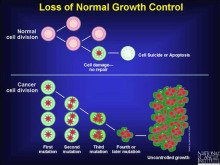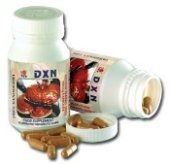Genetic Mutations
How DNA Mutation of Your Cell Causes Cancer
Learning how genetic mutations happen in your cell helps in the prevention of cancer. A DNA mutation leads to the development of tumor.
But remember that a genetic or DNA mutation in any of your millions of cells may or may not lead to cancer.
 photo courtesy of photo courtesy of National Cancer Institute |
How is this possible? Here's how . . .
At the center of every cell in your body is a gene which is made up of the DNA. The DNA is like an instruction manual, a how-to guide that directs and controls the cell's activities.
Genes often and normally undergo mutations where the sequence of the DNA is changed. Three things happen when a cell experiences a mutation...
-
1. the mutation has no effect on the gene,
2. it causes harm to the cell, or
3. it helps the cell.
When there is no effect, the cell dies and a new one grows to replace it. When the gene is able to repair itself, the cell becomes healthy once more.
But when the damage is not fixed, a disorder occurs. This is known as DNA or cell mutation and the gene is now a defective one.
How does a DNA mutation cause tumors?
It's not the DNA mutation that makes the cell cancerous. It is the defective gene caused by the change inflicted on the DNA. The damaged gene is what triggers the cell...
- to divide,
- to grow and
- to multiply out of control.
These cells that have divided, grown and multiplied out of control are now abnormal. They don't die like normal cells do and they continue to grow.
These abnormal cells clump together like a bunch of grapes to form a tumor. Now, not all tumors are created equal because a tumor can either be a benign tumor or a malignant tumor!
Some basic facts to remember about genetic or DNA mutations are:
- a genetic mutation is a permanent change in the DNA sequence which makes up a gene.
- gene mutations may be small - change occurs in a single DNA building block - or may be large - a change happens in a segment of a chromosome.
Genetic changes in your DNA also happen in two ways:
- Germline mutation which causes hereditary cancers
- Somatic mutation which causes sporadic cancers, one of the three kinds of cancer.
This is an important distinction to keep in mind in terms of both the roles and the effects of genetic mutation on the development of tumor in your body.
Changes in your genes are factors in what causes cancer. Mutations that occur either only in an egg or sperm cell, or those that occur just after fertilization, are called new or de novo mutations.
De novo mutations may explain genetic disorders in which an affected child has a DNA mutation in every cell, but has no family history of the disorder.
Related Facts:
What is A Benign Tumor?
Hereditary Cancers - Is Cancer Hereditary?
Malignant Tumor
Somatic Mutation
Return from Genetic Mutations to Cancer Prevention
Looking for something? Use Google Search box to find it! |
 Ganoderma Extract Supplements |


